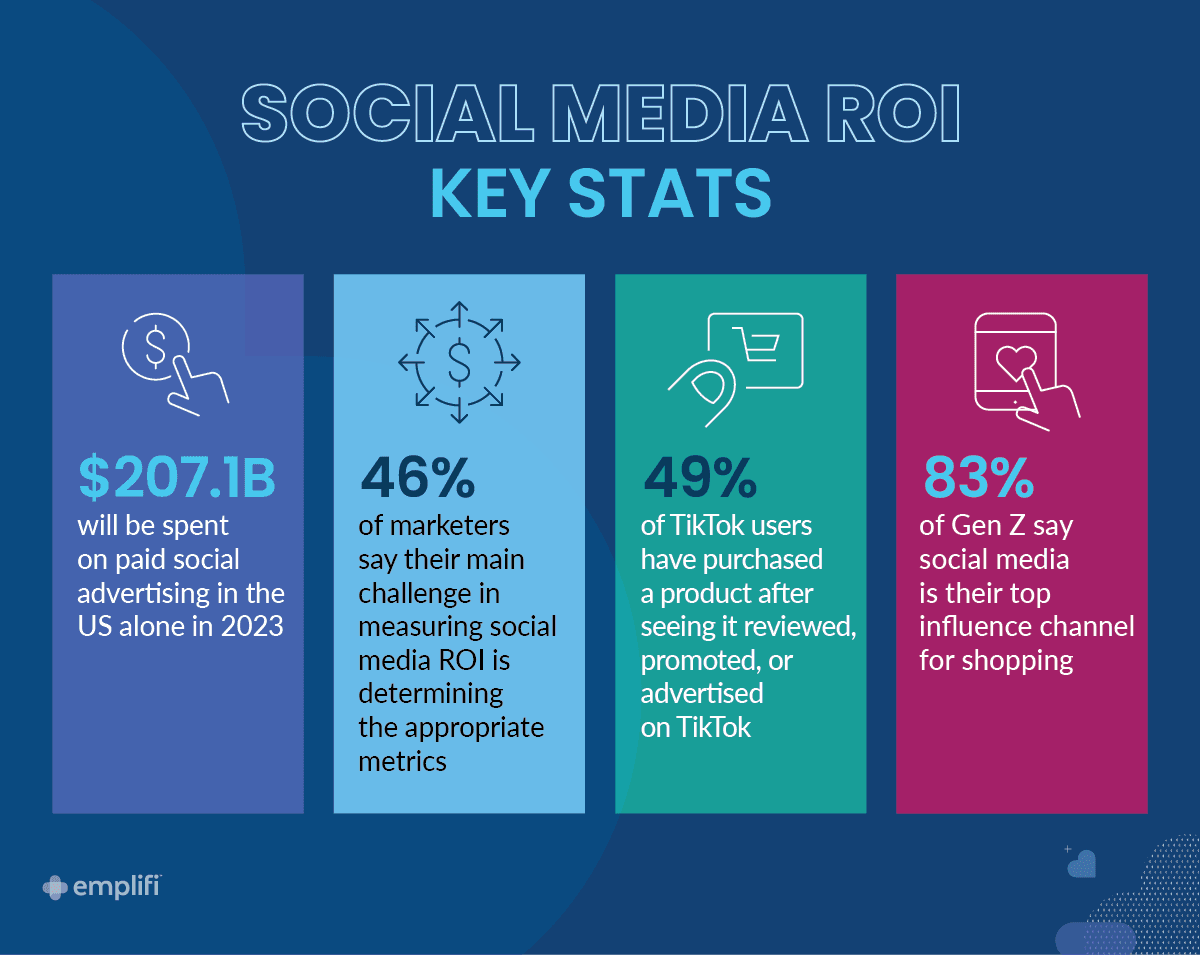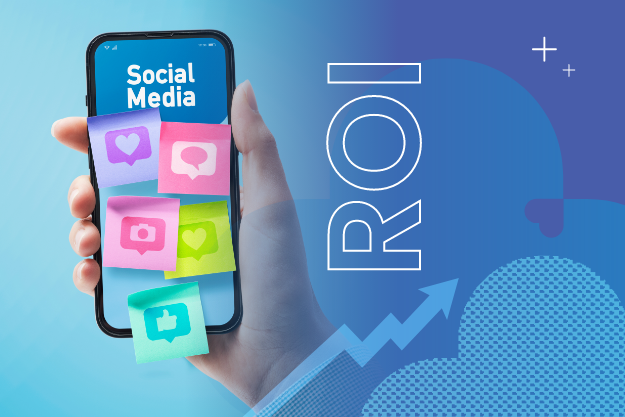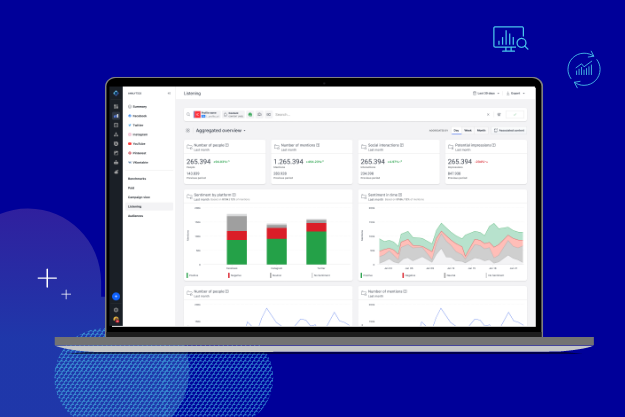It can be a daunting task to quantify the ROI of your social media marketing efforts, especially when it comes to organic social media since your overall strategy and content output isn’t tied directly to specific CTAs or attribution links. Even when it comes to paid social, outside of D2C (direct-to-customer) and eCommerce, it can be difficult to measure how much value your paid ads are returning.
1. What is social media ROI?
Social media ROI is a metric showing the amount of value generated by your investments in social media. ROI is typically measured in terms of monetary value. However, in cases where the direct impact on revenue is difficult to attribute, ROI can first be quantified by non-monetary metrics.
For example, if the goal of a paid campaign on social is to increase brand awareness and influence, ROI could be measured by growth in follower count or post-impressions.
The metrics used to quantify social media ROI for your own business should depend entirely on your objectives.
2. Why is it critical to quantify and measure ROI on social media?
There are several reasons why measuring social media ROI should be a priority for your business:
Demonstrate the value of your social media marketing efforts to your brand.
Prove that your social media marketing strategies are effective and are driving the intended results.
Identify the areas of your strategy that are most successful, so you can double down on what works and fix what doesn’t.
Back up and inform budget allocations for social media.
3. How do you calculate social media ROI?
The most basic social media ROI formula appears as follows:
Profit / Investment x 100 = social media ROI %
Profit: The money you have earned from your social media marketing efforts
Investment: The total cost of your social media marketing efforts
It’s easy to use this formula to calculate ROI for social media campaigns and initiatives that can be easily attributed to revenue (for example, paid ads for eCommerce products). But things get more complicated when dealing with the investments in social media that bring in less tangible value.
As mentioned, in cases where the direct impact on revenue is difficult to attribute, ROI can first be quantified by non-monetary metrics (increase in audience, number of sign-ups for the newsletter, etc).
While you could simply state your ROI in terms of these figures, the end game is still to attribute the corresponding monetary value of your investment in social.
To do this, we need to take a closer look at your marketing funnel and customer journey to identify where social media comes into play:
4. What is needed to attribute and quantify social media ROI?
The right tools are as important as the right method of calculating social media ROI. Here’s what you can use:
Facebook Ads with Facebook Pixel: Facebook Pixel provides crucial breakdowns of traffic, attribution, and conversion data for paid ads.
Google Analytics with UTM parameters: GA gives you the ability to set up and customize an attribution system that works for your strategy.
Ads benchmarks: Get an accurate measurement of your social media ROI by understanding how the return on Facebook ads investment is fluctuating day-by-day across regions and industries.
5. The importance of benchmarking ROI for paid social (CPC, CTR, and more)
Monitoring your social media ROI in the context of the market is critical. It enables you to detect and act on bigger trends when it comes to things like cost-per-click (CPC) and click-through rate (CTR).
The social media landscape is constantly evolving. Algorithm changes, seasonal campaigns, new competitors – all of which can impact your revenue. Keeping an eye on how your paid ROI is fluctuating in relation to your market is critical for creating and maintaining a robust social media marketing strategy.
6. How to report on social media performance and ROI
You’ve calculated your revenue. Now, it’s time to report on it.
Wondering where to start? Here are a few simple steps you should follow to create an insightful social media ROI report:
Analyze each social media platform, ad format, and ad placement separately to assess the biggest contributor to your revenue.
Align metrics you want to include in your report with the company’s marketing objectives.
Measure and present data stretching over a period of time that’s long enough to demonstrate the impact of your social media marketing activities.
Alongside the data, present key insights that accurately describe how the less tangible components of your social strategy contributed to the bottom line.
Identify areas of your strategy that were profitable and those that fell short.
Show the actionability of the data, and map out changes and adjustments that will be made to improve ROI.
7. Key Statistics About Social Media ROI

Are you wondering what tracking revenue looks like for other marketers? Here are four social media ROI stats that will add context to your ROI measurement efforts:
$207.1B is expected to be spent on paid social advertising in the US alone in 2023.
46% of marketers say their main challenge in measuring social media ROI is determining the appropriate metrics to use.
49% of TikTok users have purchased a product after seeing it reviewed, promoted, or advertised on TikTok, according to a 2021 Adweek survey on consumer behavior.
83% of Gen Z say social media is their top influence channel for shopping.
8. Social media optimization (SMO) and improving social media ROI
Improving your ROI on social media starts with social media optimization (SMO). In practice, this means spending money where you can get the best possible results in return.
Here’s how to use your social media budget more efficiently:
Don’t rely on gut feeling when choosing content to promote. Be data-driven and use your social media management platform of choice to selectively invest in posts with the highest potential to drive results.
Publish content when your audiences are online and most likely to respond to ensure the best performance for all your organic and non-paid activity on social media.
Be aware of the competition so you can make the best strategic and tactical decisions about the content you promote and in which to invest.
The Takeaway
Your business's social media ROI metrics should be chosen based solely on your objectives.
Measuring the ROI of social media campaigns can help prove the value of your social media campaigns and allocate budgets accordingly.
While calculating social media ROI for paid advertising can be based on monetary value, organic social media requires non-monetary metrics to be factored in.
Choose the right tools to calculate social media ROI, as it’s of equal importance to determining the method of calculation.
It’s crucial to monitor the fluctuations of your paid ROI in relation to the market to establish and sustain a strong social media marketing strategy.
Create a social media ROI report outlining the relevant data, analytics, and any actionable items.
Rely on social media optimization to calculate social media ROI in order to ensure data-driven results.
Social media marketing has matured to a point where measuring its ROI is a critical component of any marketing team’s day-to-day agenda. Whereas a basic social media presence was simply a box for brands to check in the past, today, the way brands leverage social media can profoundly impact the overall success of their business.







































